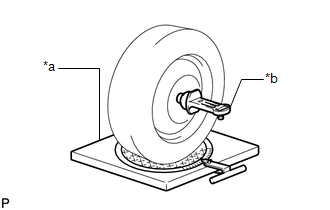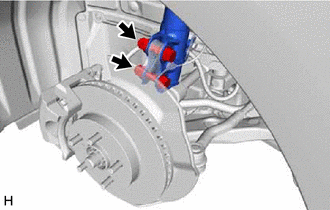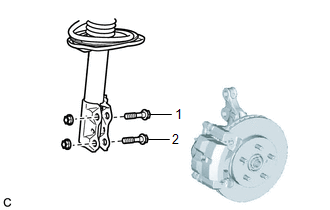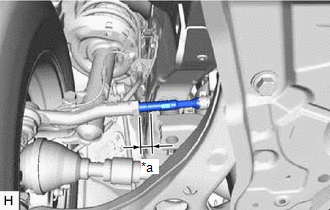Toyota CH-R Service Manual: Adjustment
ADJUSTMENT
CAUTION / NOTICE / HINT
The necessary procedures (adjustment, calibration, initialization, or registration) that must be performed after completing the front wheel alignment procedure are shown below.
Necessary Procedures After Procedure Performed|
Replaced Part or Performed Procedure |
Necessary Procedure |
Effect/Inoperative Function when Necessary Procedure not Performed |
Link |
|---|---|---|---|
|
Front wheel alignment adjustment |
|
|
|
PROCEDURE
1. INSPECT TIRES
Click here
.gif)
.gif)
2. MEASURE VEHICLE HEIGHT
NOTICE:
- Before inspecting the wheel alignment, adjust the vehicle height to the specified value.
- Be sure to perform measurement on a level surface.
- If it is necessary to go under the vehicle for measurement, confirm that the parking brake is applied and the vehicle is secured with chocks.
- Inspect while the vehicle is unloaded.
- The standard value shown here is a value that is used for performing a wheel alignment and does not indicate the height of an actual vehicle.
(a) Bounce the vehicle up and down at the corners to stabilize the suspension.
|
(b) Measure the vehicle height.
Measurement Points:
Vehicle Height (Unloaded Vehicle):
|
|
3. INSPECT CAMBER, CASTER AND STEERING AXIS INCLINATION
NOTICE:
Inspect while the vehicle is unloaded.
|
(a) Install a camber-caster-kingpin gauge and place the front wheels on the center of a turning radius gauge. |
|
(b) Inspect the camber, caster and steering axis inclination.
Camber (Unloaded Vehicle):
|
Vehicle Model |
Camber Inclination |
Right-left Difference |
|---|---|---|
|
ZGX10L-AHXEPX ZGX10L-AHXGPX ZGX10L-AHXNPX |
0°06' +/- 0°45' (0.10° +/- 0.75°) |
0°45' (0.75°) or less |
|
ZGX10L-BHXNPA |
0°01' +/- 0°45' (0.02° +/- 0.75°) |
0°45' (0.75°) or less |
Caster (Unloaded Vehicle):
|
Vehicle Model |
Caster Inclination |
Right-left Difference |
|---|---|---|
|
ZGX10L-AHXEPX ZGX10L-AHXGPX ZGX10L-AHXNPX |
6°36' +/- 0°45' (6.60° +/- 0.75°) |
0°45' (0.75°) or less |
|
ZGX10L-BHXNPA |
6°45' +/- 0°45' (6.75° +/- 0.75°) |
0°45' (0.75°) or less |
Steering Axis Inclination (Unloaded Vehicle):
|
Vehicle Model |
Steering Axis Inclination Reference |
|---|---|
|
ZGX10L-AHXEPX ZGX10L-AHXGPX ZGX10L-AHXNPX |
13°49' (13.82°) |
|
ZGX10L-BHXNPA |
14°02' (14.03°) |
4. ADJUST CAMBER
NOTICE:
Inspect toe-in after the camber has been adjusted.
(a) Remove the front wheel.
Click here
.gif)
.gif)
|
(b) Remove the 2 nuts on the lower side of the front shock absorber assembly. NOTICE: Keep the bolts inserted. |
|
(c) Remove the top and bottom bolts one at a time and confirm that the steering knuckle can move freely in the front shock absorber assembly.
HINT:
- Reinstall each bolt after removing it and confirming steering knuckle movement.
- If the steering knuckle does not move freely in the front shock absorber assembly, clean the contact surfaces of the front shock absorber assembly and the steering knuckle.
(d) Temporarily install the 2 nuts. (Step A)
|
(e) Fully push or pull the front axle hub in the direction of the required adjustment. (Step B) |
|
|
(f) Tighten the 2 nuts. Torque: 270 N·m {2753 kgf·cm, 199 ft·lbf} NOTICE: Keep the bolts from rotating when tightening the nuts. |
|
(g) Install the front wheel.
Click here
.gif)
.gif)
(h) Bounce the vehicle up and down at the corners to stabilize the suspension.
(i) Check the camber.
Camber (Unloaded Vehicle):
|
Vehicle Model |
Camber Inclination |
Right-left Difference |
|---|---|---|
|
ZGX10L-AHXEPX ZGX10L-AHXGPX ZGX10L-AHXNPX |
0°06' +/- 0°30' (0.10° +/- 0.50°) |
0°45' (0.75°) or less |
|
ZGX10L-BHXNPA |
0°01' +/- 0°30' (0.02° +/- 0.50°) |
0°45' (0.75°) or less |
|
(1) If the measured value is not within the specification, calculate the required adjustment amount using the formula below. Camber adjustment amount = center of the specified range - measured value Check the combination of the installed bolts. Select appropriate bolts from the tables below to adjust the camber to the specified values. HINT: Try to adjust the camber to the center of the specified values.
The vehicle body and suspension may be damaged if the camber cannot be correctly adjusted according to the table above. NOTICE: Replace the nut with a new one when replacing the bolt. |
|
(2) Table (1) (To move the axle hub toward the positive side)
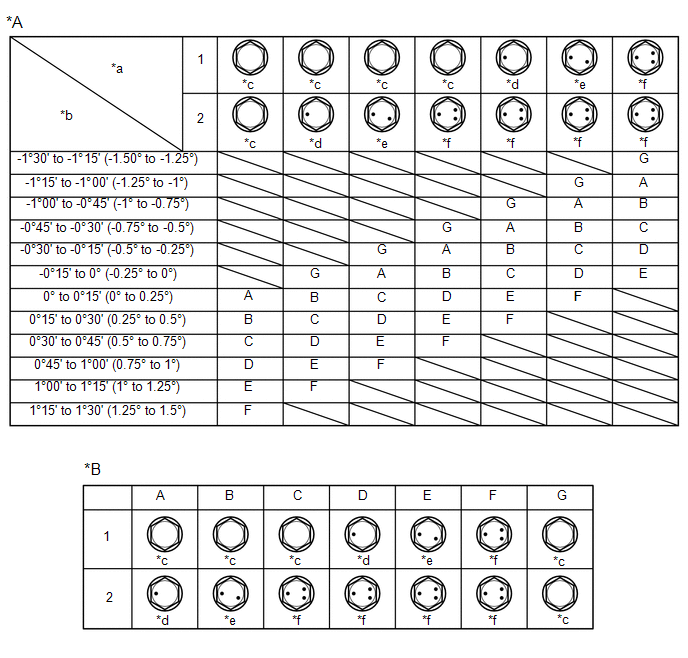
|
*A |
Table (1) (To move the axle hub toward the positive side) |
*B |
Selected Bolt Combination |
|
*a |
Installed Bolt |
*b |
Adjusting Value |
|
*c |
Standard Bolt |
*d |
90105-17009 |
|
*e |
90105-17010 |
*f |
90105-17011 |
(3) Table (2) (To move the axle hub toward the negative side)
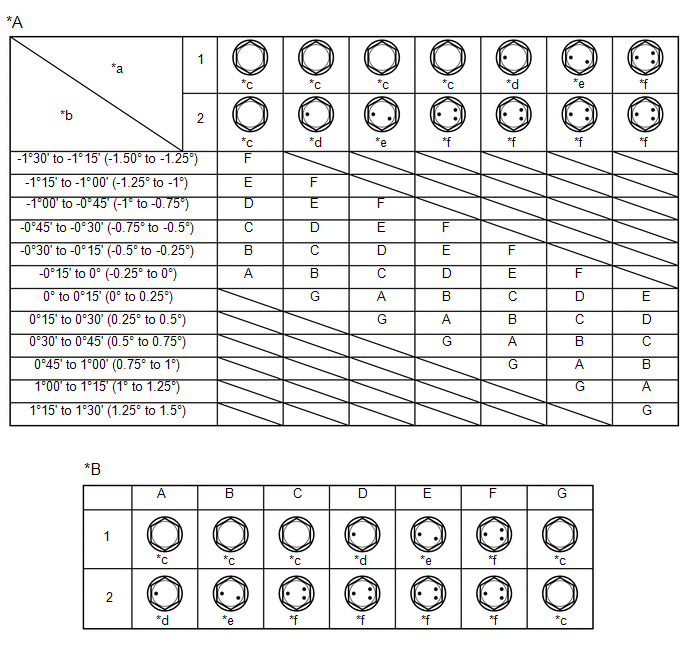
|
*A |
Table (2) (To move the axle hub toward the negative side) |
*B |
Selected Bolt Combination |
|
*a |
Installed Bolt |
*b |
Adjusting Value |
|
*c |
Standard Bolt |
*d |
90105-17009 |
|
*e |
90105-17010 |
*f |
90105-17011 |
(j) If the camber was out of adjustment in the previous step, perform the adjust camber steps mentioned above. In step A, replace the existing bolts with the selected bolts.
HINT:
Replace one bolt at a time when replacing both bolts.
5. INSPECT TOE-IN
NOTICE:
Inspect while the vehicle is unloaded.
(a) Bounce the vehicle up and down at the corners to stabilize the suspension.
(b) Release the parking brake and move the shift lever to N.
(c) Push the vehicle straight ahead approximately 5 m (16.4 ft.). (Step C)
(d) Put tread center marks on the rearmost points of the front wheels and measure the distance between the marks (dimension B).
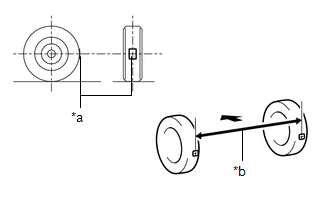
|
*a |
Tread Center Mark |
|
*b |
Dimension B |
.png) |
Front of the Vehicle |
(e) Slowly push the vehicle straight ahead to cause the front wheels to rotate 180°. Use the front tire valve as a reference point.
HINT:
Do not allow the wheels to rotate more than 180°. If the wheels rotate more than 180°, perform the procedure from step C again.
(f) Measure the distance between the tread center marks on the front of the wheels (dimension A).

|
*a |
Dimension A |
.png) |
Front of the Vehicle |
Toe-in (Unloaded Vehicle):
|
Vehicle Model |
Specified Condition |
|---|---|
|
ZGX10L-AHXEPX ZGX10L-AHXGPX ZGX10L-AHXNPX |
C + D: 0°06' +/- 0°10' (0.11° +/- 0.17°) |
|
B - A: 1.3 +/- 2.0 mm (0.0512 +/- 0.0787 in.) |
|
|
ZGX10L-BHXNPA |
C + D: 0°07' +/- 0°10' (0.12° +/- 0.17°) |
|
B - A: 1.4 +/- 2.0 mm (0.0551 +/- 0.0787 in.) |
HINT:
Measure "B - A" only when "C + D" cannot be measured.
If the toe-in is not within the specified range, adjust it at the steering rack ends.
6. ADJUST TOE-IN
|
(a) Make sure that the thread length of the right and left steering rack ends are approximately the same. Standard Difference: 1.5 mm (0.0591 in.) or less |
|
(b) Remove the steering rack boot clips.
|
(c) Loosen the tie rod end sub-assembly lock nuts. |
|
(d) Adjust the steering rack ends if the difference in thread length between the right and left steering rack ends is not within the specified range.
(1) If the toe-in measurement is greater than the specified range (too much toe-out), extend the shorter rack end so that the difference in length is within the specified range.
(2) If the toe-in measurement is less than the specified range (too much toe-in), shorten the longer rack end so that the difference in length is within the specified range.
(3) Measure the toe-in.
(e) Turn the right and left steering rack ends by an equal amount to adjust the toe-in.
Toe-in (Unloaded Vehicle):
|
Vehicle Model |
Specified Condition |
|---|---|
|
ZGX10L-AHXEPX ZGX10L-AHXGPX ZGX10L-AHXNPX |
C + D: 0°06' +/- 0°05' (0.11° +/- 0.08°) |
|
B - A: 1.3 +/- 1.0 mm (0.0512 +/- 0.0394 in.) |
|
|
ZGX10L-BHXNPA |
C + D: 0°07' +/- 0°05' (0.12° +/- 0.08°) |
|
B - A: 1.4 +/- 1.0 mm (0.0551 +/- 0.0394 in.) |
HINT:
Perform adjustments so that the value is as close as possible to the median of the specified range.
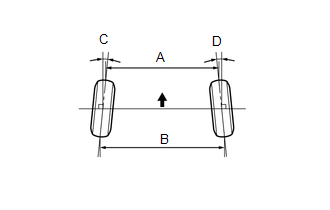
.png) |
Front of the Vehicle |
(f) Make sure that the thread length of the right and left steering rack ends are the same.
(g) Tighten the tie rod end sub-assembly lock nuts.
Torque:
74 N·m {755 kgf·cm, 55 ft·lbf}
(h) Place the steering rack boots on the seats and install the steering rack boot clips.
HINT:
Make sure that the steering rack boots are not twisted.
7. INSPECT WHEEL ANGLE
(a) Put tread center marks on the rearmost points of a turning radius gauge.

|
*a |
Inside |
|
*b |
Outside |
.png) |
Front of the Vehicle |
(b) Turn the steering wheel fully to the left and right and measure the turning angle.
NOTICE:
Inspect while the vehicle is unloaded.
Wheel Turning Angle (Unloaded Vehicle):
|
Vehicle Model |
Inside Wheel |
Outside Wheel |
|---|---|---|
|
ZGX10L-AHXEPX ZGX10L-AHXGPX ZGX10L-AHXNPX |
39°30' +/- 2°00' (39.50° +/- 2.00°) |
33°50' (33.83°) |
|
ZGX10L-BHXNPA |
39°15' +/- 2°00' (39.25° +/- 2.00°) |
33°34' (33.57°) |
- If the right and left inside wheel angles differ from the specified value, check and adjust the right and left steering rack end lengths.
8. ALIGN FRONT WHEELS FACING STRAIGHT AHEAD
9. PERFORM YAW RATE AND ACCELERATION SENSOR CALIBRATION
Click here
.gif)
Other materials:
Toyota CH-R Service Manual > Oil Pan: Components
COMPONENTS
ILLUSTRATION
*1
NO. 1 ENGINE UNDER COVER
*2
REAR ENGINE UNDER COVER LH
N*m (kgf*cm, ft.*lbf): Specified torque
-
-
ILLUSTRATION
*1
OIL CLEANER (CVT) MAGNET
...
Toyota CH-R Service Manual > Audio / Video: Stereo Jack Adapter Assembly
Components
COMPONENTS
ILLUSTRATION
*1
INSTRUMENT CLUSTER FINISH PANEL GARNISH ASSEMBLY
*2
INSTRUMENT PANEL BOX ASSEMBLY
*3
INSTRUMENT PANEL LOWER CENTER FINISH PANEL
*4
NO. 1 STEREO JACK ADAPTER ASSE ...
Toyota C-HR (AX20) 2023-2026 Owner's Manual
Toyota CH-R Owners Manual
- For safety and security
- Instrument cluster
- Operation of each component
- Driving
- Interior features
- Maintenance and care
- When trouble arises
- Vehicle specifications
- For owners
Toyota CH-R Service Manual
- Introduction
- Maintenance
- Audio / Video
- Cellular Communication
- Navigation / Multi Info Display
- Park Assist / Monitoring
- Brake (front)
- Brake (rear)
- Brake Control / Dynamic Control Systems
- Brake System (other)
- Parking Brake
- Axle And Differential
- Drive Shaft / Propeller Shaft
- K114 Cvt
- 3zr-fae Battery / Charging
- Networking
- Power Distribution
- Power Assist Systems
- Steering Column
- Steering Gear / Linkage
- Alignment / Handling Diagnosis
- Front Suspension
- Rear Suspension
- Tire / Wheel
- Tire Pressure Monitoring
- Door / Hatch
- Exterior Panels / Trim
- Horn
- Lighting (ext)
- Mirror (ext)
- Window / Glass
- Wiper / Washer
- Door Lock
- Heating / Air Conditioning
- Interior Panels / Trim
- Lighting (int)
- Meter / Gauge / Display
- Mirror (int)
- Power Outlets (int)
- Pre-collision
- Seat
- Seat Belt
- Supplemental Restraint Systems
- Theft Deterrent / Keyless Entry
0.0079


